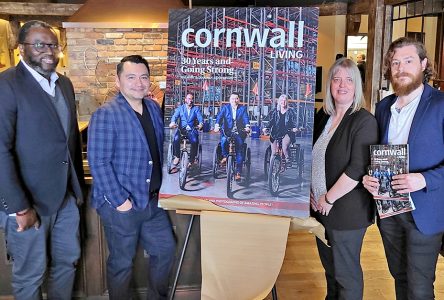By Adam Brazeau
AKWESASNE – The stomp of a thousand moccasins lightly shook the ground, as the song cry of a First Nations drum circle pierced the air. Dancers draped in bold feathers, buckskin regalia and brightly coloured beads showcased their Indigenous culture, in captivating style.
That was the scene of the Grand Entry at the first day of the Akwesasne International Pow-Wow.
For First Nations traditional dancer Don White Jr., from Akwesasne, putting on his regalia and performing the renowned dance of his elders and ancestors is more than the actual movements.
“I get into a zone when I dance. It’s a spiritual thing. I’m telling my story,” said White, 33. “This has always been a part of who native people are.”
White said his dance is a “representation of warriors and hunters,” that shows mobility, pride in Indigenous culture and respect for the deceased and those who are physically unable to dance. It also brings luck to his Aboriginal hunting instruments.
“It’s a chance to represent my family, where I’m from and who I am,” said White. “Passing it to my children is a big reason to dance and be here.”
White’s two children, Taylan, 9, and Kalea, 2, were also performing at the Pow-Wow in the jingle dance portion of the event.
His wife, Tanya Derouchie, from Cornwall, was one of many non-natives enjoying the open welcome from a neighbouring community into a two-day event of breathtaking cultural performances.
“It’s great to see my family’s heritage in movement,” said Derouchie.
The Laures, from Montreal, were at their first Pow-Wow and they described it as “really spectacular.”
“Akwesasne has a great reputation of being friendly and it was close, so we decided to come,” said Anne Laure.
Her husband Franck agreed that it was “beautiful to see young children dancing in traditional regalia.”
Their son Clovis, kept a steady beat on his tiny First Nations drum.
“He loves all the drumming at the Pow-Wow,” said Anne.
The international portion of the event, aside from the dozens of First Nations dancers from all over America and even some from Mexico, was the Remesha Drum Group, from Burundi, Africa and a young documentary crew from Belgium.
The Remesha Drum Group bursted onto the field with a lively performance of chanting, loud red costumes and thunderous drum claps. The amount of energy each performer made as they did an individual dance for the crowd left many in a state of awe and excitement.
Capturing all the nuances of the Pow-Wow were a trio of female journalism students from I.H.E.C.S. in Brussels. They’re enjoying a 22-day visit to Canada to film their final school project: a documentary on the Akwesasne International Pow-Wow.
“In Europe, people don’t know how natives live. They think it’s still the way it was a long time ago,” said Hélene Servais.
“We’re here to discover native history and we want to meet a family with little children to see what their lives are really like,” said Mariam Alard.
The third journalism student from overseas, Laurence Swaelvs, was busy chasing the perfect shot of First Nations heritage for their documentary footage.
A little further, the smell of homemade Native American traditional foods distracted some spectators, briefly, for a chance to indulge in another overload to the senses. Plus, native handcrafted beads, jewelry, arts and crafts were being sold.
At her eighth Pow-Wow this year, First Nations traditional dancer Caitlyn Nicholas, 16, performed southern style dancing. It was her first time at the Akwesasne event, which is celebrating its 13th year.
“I didn’t expect it to be so big,” said Nicholas, from London, Ontario. “It feels good to be around so many people who share the same heritage and beliefs.”
Nicholas said she makes new friends as she travels to various Pow-Wows with her family and enjoys sharing her dancing with other cultures.
“I dance because it’s part of who I am,” she said.


